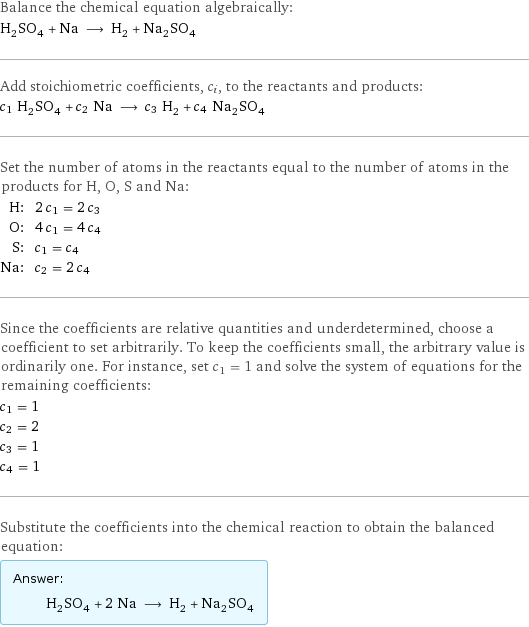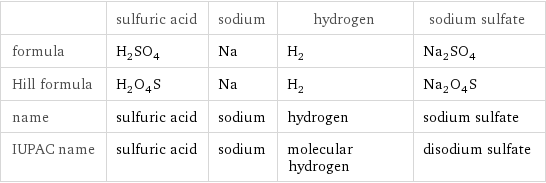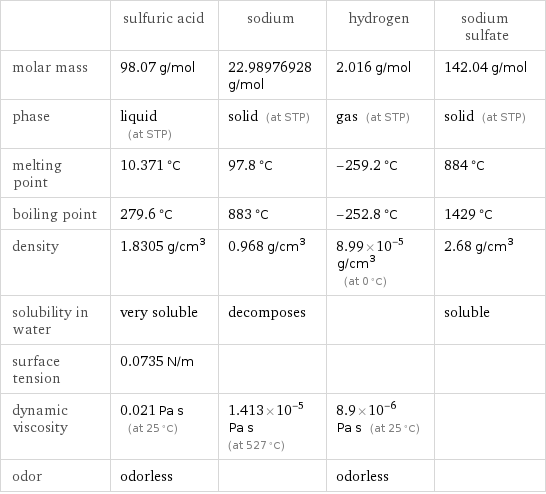Input interpretation

H_2SO_4 (sulfuric acid) + Na (sodium) ⟶ H_2 (hydrogen) + Na_2SO_4 (sodium sulfate)
Balanced equation

Balance the chemical equation algebraically: H_2SO_4 + Na ⟶ H_2 + Na_2SO_4 Add stoichiometric coefficients, c_i, to the reactants and products: c_1 H_2SO_4 + c_2 Na ⟶ c_3 H_2 + c_4 Na_2SO_4 Set the number of atoms in the reactants equal to the number of atoms in the products for H, O, S and Na: H: | 2 c_1 = 2 c_3 O: | 4 c_1 = 4 c_4 S: | c_1 = c_4 Na: | c_2 = 2 c_4 Since the coefficients are relative quantities and underdetermined, choose a coefficient to set arbitrarily. To keep the coefficients small, the arbitrary value is ordinarily one. For instance, set c_1 = 1 and solve the system of equations for the remaining coefficients: c_1 = 1 c_2 = 2 c_3 = 1 c_4 = 1 Substitute the coefficients into the chemical reaction to obtain the balanced equation: Answer: | | H_2SO_4 + 2 Na ⟶ H_2 + Na_2SO_4
Structures

+ ⟶ +
Names

sulfuric acid + sodium ⟶ hydrogen + sodium sulfate
Reaction thermodynamics
Enthalpy

| sulfuric acid | sodium | hydrogen | sodium sulfate molecular enthalpy | -814 kJ/mol | 0 kJ/mol | 0 kJ/mol | -1387 kJ/mol total enthalpy | -814 kJ/mol | 0 kJ/mol | 0 kJ/mol | -1387 kJ/mol | H_initial = -814 kJ/mol | | H_final = -1387 kJ/mol | ΔH_rxn^0 | -1387 kJ/mol - -814 kJ/mol = -573.1 kJ/mol (exothermic) | | |
Equilibrium constant
![Construct the equilibrium constant, K, expression for: H_2SO_4 + Na ⟶ H_2 + Na_2SO_4 Plan: • Balance the chemical equation. • Determine the stoichiometric numbers. • Assemble the activity expression for each chemical species. • Use the activity expressions to build the equilibrium constant expression. Write the balanced chemical equation: H_2SO_4 + 2 Na ⟶ H_2 + Na_2SO_4 Assign stoichiometric numbers, ν_i, using the stoichiometric coefficients, c_i, from the balanced chemical equation in the following manner: ν_i = -c_i for reactants and ν_i = c_i for products: chemical species | c_i | ν_i H_2SO_4 | 1 | -1 Na | 2 | -2 H_2 | 1 | 1 Na_2SO_4 | 1 | 1 Assemble the activity expressions accounting for the state of matter and ν_i: chemical species | c_i | ν_i | activity expression H_2SO_4 | 1 | -1 | ([H2SO4])^(-1) Na | 2 | -2 | ([Na])^(-2) H_2 | 1 | 1 | [H2] Na_2SO_4 | 1 | 1 | [Na2SO4] The equilibrium constant symbol in the concentration basis is: K_c Mulitply the activity expressions to arrive at the K_c expression: Answer: | | K_c = ([H2SO4])^(-1) ([Na])^(-2) [H2] [Na2SO4] = ([H2] [Na2SO4])/([H2SO4] ([Na])^2)](../image_source/29296b235395936ee0880d93e81b8b5a.png)
Construct the equilibrium constant, K, expression for: H_2SO_4 + Na ⟶ H_2 + Na_2SO_4 Plan: • Balance the chemical equation. • Determine the stoichiometric numbers. • Assemble the activity expression for each chemical species. • Use the activity expressions to build the equilibrium constant expression. Write the balanced chemical equation: H_2SO_4 + 2 Na ⟶ H_2 + Na_2SO_4 Assign stoichiometric numbers, ν_i, using the stoichiometric coefficients, c_i, from the balanced chemical equation in the following manner: ν_i = -c_i for reactants and ν_i = c_i for products: chemical species | c_i | ν_i H_2SO_4 | 1 | -1 Na | 2 | -2 H_2 | 1 | 1 Na_2SO_4 | 1 | 1 Assemble the activity expressions accounting for the state of matter and ν_i: chemical species | c_i | ν_i | activity expression H_2SO_4 | 1 | -1 | ([H2SO4])^(-1) Na | 2 | -2 | ([Na])^(-2) H_2 | 1 | 1 | [H2] Na_2SO_4 | 1 | 1 | [Na2SO4] The equilibrium constant symbol in the concentration basis is: K_c Mulitply the activity expressions to arrive at the K_c expression: Answer: | | K_c = ([H2SO4])^(-1) ([Na])^(-2) [H2] [Na2SO4] = ([H2] [Na2SO4])/([H2SO4] ([Na])^2)
Rate of reaction
![Construct the rate of reaction expression for: H_2SO_4 + Na ⟶ H_2 + Na_2SO_4 Plan: • Balance the chemical equation. • Determine the stoichiometric numbers. • Assemble the rate term for each chemical species. • Write the rate of reaction expression. Write the balanced chemical equation: H_2SO_4 + 2 Na ⟶ H_2 + Na_2SO_4 Assign stoichiometric numbers, ν_i, using the stoichiometric coefficients, c_i, from the balanced chemical equation in the following manner: ν_i = -c_i for reactants and ν_i = c_i for products: chemical species | c_i | ν_i H_2SO_4 | 1 | -1 Na | 2 | -2 H_2 | 1 | 1 Na_2SO_4 | 1 | 1 The rate term for each chemical species, B_i, is 1/ν_i(Δ[B_i])/(Δt) where [B_i] is the amount concentration and t is time: chemical species | c_i | ν_i | rate term H_2SO_4 | 1 | -1 | -(Δ[H2SO4])/(Δt) Na | 2 | -2 | -1/2 (Δ[Na])/(Δt) H_2 | 1 | 1 | (Δ[H2])/(Δt) Na_2SO_4 | 1 | 1 | (Δ[Na2SO4])/(Δt) (for infinitesimal rate of change, replace Δ with d) Set the rate terms equal to each other to arrive at the rate expression: Answer: | | rate = -(Δ[H2SO4])/(Δt) = -1/2 (Δ[Na])/(Δt) = (Δ[H2])/(Δt) = (Δ[Na2SO4])/(Δt) (assuming constant volume and no accumulation of intermediates or side products)](../image_source/a06f557b4cee5698d3ae1f10b6a011ac.png)
Construct the rate of reaction expression for: H_2SO_4 + Na ⟶ H_2 + Na_2SO_4 Plan: • Balance the chemical equation. • Determine the stoichiometric numbers. • Assemble the rate term for each chemical species. • Write the rate of reaction expression. Write the balanced chemical equation: H_2SO_4 + 2 Na ⟶ H_2 + Na_2SO_4 Assign stoichiometric numbers, ν_i, using the stoichiometric coefficients, c_i, from the balanced chemical equation in the following manner: ν_i = -c_i for reactants and ν_i = c_i for products: chemical species | c_i | ν_i H_2SO_4 | 1 | -1 Na | 2 | -2 H_2 | 1 | 1 Na_2SO_4 | 1 | 1 The rate term for each chemical species, B_i, is 1/ν_i(Δ[B_i])/(Δt) where [B_i] is the amount concentration and t is time: chemical species | c_i | ν_i | rate term H_2SO_4 | 1 | -1 | -(Δ[H2SO4])/(Δt) Na | 2 | -2 | -1/2 (Δ[Na])/(Δt) H_2 | 1 | 1 | (Δ[H2])/(Δt) Na_2SO_4 | 1 | 1 | (Δ[Na2SO4])/(Δt) (for infinitesimal rate of change, replace Δ with d) Set the rate terms equal to each other to arrive at the rate expression: Answer: | | rate = -(Δ[H2SO4])/(Δt) = -1/2 (Δ[Na])/(Δt) = (Δ[H2])/(Δt) = (Δ[Na2SO4])/(Δt) (assuming constant volume and no accumulation of intermediates or side products)
Chemical names and formulas

| sulfuric acid | sodium | hydrogen | sodium sulfate formula | H_2SO_4 | Na | H_2 | Na_2SO_4 Hill formula | H_2O_4S | Na | H_2 | Na_2O_4S name | sulfuric acid | sodium | hydrogen | sodium sulfate IUPAC name | sulfuric acid | sodium | molecular hydrogen | disodium sulfate
Substance properties

| sulfuric acid | sodium | hydrogen | sodium sulfate molar mass | 98.07 g/mol | 22.98976928 g/mol | 2.016 g/mol | 142.04 g/mol phase | liquid (at STP) | solid (at STP) | gas (at STP) | solid (at STP) melting point | 10.371 °C | 97.8 °C | -259.2 °C | 884 °C boiling point | 279.6 °C | 883 °C | -252.8 °C | 1429 °C density | 1.8305 g/cm^3 | 0.968 g/cm^3 | 8.99×10^-5 g/cm^3 (at 0 °C) | 2.68 g/cm^3 solubility in water | very soluble | decomposes | | soluble surface tension | 0.0735 N/m | | | dynamic viscosity | 0.021 Pa s (at 25 °C) | 1.413×10^-5 Pa s (at 527 °C) | 8.9×10^-6 Pa s (at 25 °C) | odor | odorless | | odorless |
Units
